Sentiment Analysis in Cryptocurrency

Sentiment Analysis in Cryptocurrency
“When everyone thinks alike, everyone is likely to be wrong.”“The public is often right during the trends, but wrong at both ends”
"A 'crowd' thinks with its heart (that is, is influenced by emotions) while an individual thinks with his brain."
-Humphrey B. Neill
Why use Sentiment in your trading?
Sentiment analysis in trading is an underused part a of a trader's arsenal. There are also many misconceptions about sentiment. The crowd thinks that when sentiment is high, it is time to buy and when it is low is time to sell. I am very anti crowd mentality, that is why I prefer to be a solitary trader. I have tried to trade while interacting with other traders, but in general it has not been for me as it causes me to be swayed by group think.
Image from BabyPips.comNow I want to get one thing clear from the start. The crowd is not always wrong. It is just when the crowd reaches extreme levels that you often see them be wrong. Sentiment analysis should not be your primary method for analyzing any trade-able asset. It is an outstanding complementary tool, however. Like anything else though, it has to be applied properly. Often times it is applied incorrectly.
There are three primary schools of thought that one can use to analyze a cryptocurrency or any other asset. These are fundamental analysis, technical analysis, and sentiment analysis. I have always focused heavily on Technical Analysis as the other two schools are often baked into the price and volume trends and patterns. I do utilize fundamental research, but I will admit it is not my primary focus.
TA is my primary method for trading cryptos, and remains so. However, during the bear market I spent a considerable amount of time researching sentiment among many other things. Sentiment was instrumental in allowing me to get an excellent average price on my re-entry into BTC from a full FIAT position near the recent bottom from 6.5K to 7K. So I am a huge fan of sentiment analysis.
I have always used some form of sentiment analysis, though it was mostly subjective in the past. I have always liked to read social media posts on Reddit, Twitter, YouTube comments, TradingView bloggers, etc. This means I may or may not have a list of people that are typically "group think" oriented that have large followings on TradingView, YouTube, Reddit etc. These guys are often wrong at major market inflection points.
I also.. may or may not.. have a list of people that have the ability to think independently and thus are some of the few that are right at major market turning points. No one is always right or always wrong, that is important to remember. I just want to know who is often right or wrong when it matters most. The Bitcoin Markets subreddit daily threads are a good source for determining what the current group think is.
During the recent bottoming action that took multiple weeks in the 6.5K to 7K range, it was very hard to find a bull. Bearishness was overwhelmingly high. This is was true everywhere I looked. Even now, there are still a lot of hold out bears. I have seen so many cries of manipulation, scams, etc. This is how markets work. When people mis-analyze a market, they often make excuses for why they were wrong.
An overused term in trading is "I'm waiting for confirmation". "I'm waiting to break above XX level before going long" With sentiment analysis, you can have the confidence to enter prior to price confirmation. This is powerful. I am planning a post on why entry levels matters. I think the amount of confirmation that some traders want is excessive. With proper money management, and good analysis, you do not need as much confirmation.
It is important to point out that sentiment is most useful at market bottoms. Irrational exuberance at tops can persist for a very long time. The entire Bitcoin run up from 5.5K to 20K in a month, saw extreme bullish sentiment during the entire run. New money kept pouring into the market, combined with likely manipulation. This allowed the market to continue to push higher despite being at a sentiment extreme for a very long time. The sentiment extremes at both recent 6K bottoms in BTC did not last nearly as long. Especially the first bottom.
The basic idea with sentiment analysis, and why it works, is that once we reach extreme sentiment values there is no one left to buy or sell. Everyone has already bought or sold. Now as explained before, tops can be tricky because of the new money factor. With bottoms though new money is not a major factor, as new money does not come in and short on the first day of trading.
“As a general rule, it is foolish to do just what other people are doing, because there are almost sure to be too many people doing the same thing.” -William Stanley JevonsNew Sentiment Weaponry
Now I want to get into how I have added several tools to my sentiment toolbox. I want to give credit to the three primary sources that I used in my resource. First and foremost, Bitcoin Trading Challenge on YouTube. He puts out a ton of high quality material, not just sentiment analysis. His volume profile series and many others have come in very handy for me in my continual learning process. Even though he is a day trader and I swing/position trade the info is still very useful for me. He is an outstanding person, and what he is doing for the general public, for free is amazing.
I continue to be amazed at how the sharing economy is continuing to change the world. People are sharing information, for basically nothing, and in doing so bucking the establishment. This is a game changer. There is so many opportunities now for learning how to change your financial situation with little to no cost for your education. Take advantage of that.
Sorry for the digression. The other two primary sources I used are Charles D. Kirkpatrick's book on TA, Technical Analysis: The Complete Resource for Financial Market Technicians
and the BabyPips.com Sentiment series. There are many other sources I used, and many of them will be linked throughout the rest of this series.For this guide, I am going to be using Bitcoin as a proxy for the Crypto market. Sentiment, in general, works best when analyzing an entire market. BTC has acted as the major guiding force for the entire crypto space for a very long time and I foresee that continuing into the foreseeable future.
Bitfinex Data
Bitfinex provides a ton of data via their API that people have compiled into TradingView indicators and websites. This information is one of, if not the best, way to analyze sentiment.
Longs/Shorts
Margin longs versus margin shorts are reported by Bitfinex. This info is excellent for analyzing sentiment. You can use Datamish.com, BFXdata.com, the Tradingview indicator BFXLS100, or add BTCUSDLONGS and BTCUSDSHORTS to your charts via the compare feature in Tradingview. I prefer to use BFXLS100 and turn on the options for showing the percentage versus the raw data. I like to look at the raw data(total longs and shorts) as well as the percentage, but find the percentage gives you a better picture. On your charts, turn the left scale on, use percentage. That is my preference, find what works best for you.
First let’s look at the raw data, then we will look at the percentage data. The raw data is a little noisy, the percentage data is much more clean. I prefer to look at percentage for the most part, but I will also pop on the raw longs shorts as well.
The data is not very smoothed with this setting. The longs and shorts are both trending up, so can be a little harder to see correlations.
These are the settings for raw data(total long/short positions) in BFXLS100.
Percentage long/short. Much cleaner, easier to see correlations.
Settings for long/short % in BFXLS100.I recommend watching the entire Bitcoin Trading Challenge series. He goes in depth on how to analyze this information. Very well worth the time. He mentions in his video that he is looking for 60/40. 60% long/40% short and vice versa. For long/short ratio this is very true. However, shorts very rarely get above 50%. If you see shorts over 50%, coupled with TA confirmation(near major support/retracements), I would be looking for an entry. Shorting is typically going to be the lower number. Shorting is less profitable, if you are interested in seeing the math for why I will gladly provide it for you. It is also slightly more complex of a process to enter a short. That and most markets have more bulls than bears, most of the time. So shorting is always going to be less prevalent. In those rare cases where shorts exceed 50%, unless it for some reason is at an all-time high, I advise looking for an entry in most cases.
Remember the epic short squeeze when we broke out of the 6.5K to 7K base? Now you can see why, if you look at how extremely out of whack shorts had gotten. This is what a contrarian is looking for. Combining the very strong sentiment indications(massive shorts, longs dropping, bearishness everywhere on social media/news), with TA could have gotten you in near the bottom.
The TA was showing a potential bottom was forming, and you had two weeks to notice this. A market structure ‘W’ near the double bottom with the 6K panic low, every single attempt to push lower was immediately bought back up if you watched price action, the volume was relatively light in the base(it is a misconception that you need huge volume in a bottoming structure like this. You see big volume on a capitulation sell off, most of the time you do not on a basing bottom like this. However, if you aggregate the volume with something like Volume Profile you can see that there was plenty of transactions taking place in that bottom.
It is always interesting how when people missed the first 6K bottom, they were all ready to buy if we got back down there. Then we did get back there, and few of them bought. Instead manipulation was blamed. This is a cliché that repeats time and again throughout the history of financial markets. These same statements are repeated over and over again(“Markets are too manipulated.”, “Technical Analysis doesn’t work.”, “This time is different”.) I am not trying to downplay manipulation in these markets. Yes it exists. However, I would contend, that despite regulation, the U.S. Stock market is more heavily manipulated.
There is a printing press that continually pumps stock prices higher year after year, well past normal valuation levels. Insider trading amongst the large banks, I suspect, is commonplace. There is little oversight of these people. The SEC is undermanned and payed off. So despite laws existing, cheating is probably more severe in traditional markets. Many think they will get away with pump and dumps and insider trading in crypto. They may for a while, but existing laws do apply to crypto in most countries that have existing laws.
Back to the charts. Looking at recent major inflection points, what can we discern? I have marked up this chart of BFXLS100 longs and shorts with percentage turned on and showed my observations. I highly encourage you to do the same.
I encourage to look at just longs, just shorts, and both at the same time when doing your sentiment analysis. Also look at the non-percentage adjusted longs shorts.
Bennett with Bitcoin Trading Challenge has a cheat sheet he has shared that shows how he uses this powerful data. Here it is:
I will not get into all the details on here. He explains this all very well. For me as a longer term trader, I do not utilize every aspect of his sentiment methodology.
Margin Rates
Bennett with BTTC also explains this very well. I think this can be useful as well, but not as much use as longs/shorts IMO. Margin levels are used as a sentiment indicator across all markets. But margin rates are a little different. Bitfinex and many of the margin exchanges in crypto, use peer to peer lending to offer margin. This allows us to see the margin rates.
The basic idea is when margin rates get very high, that might mean we are seeing an extreme. Extremes can be a reversal sign, especially when coupled with an extreme in short or long positions. Since shorting requires margin use, it could signify extreme shorting if near a major support or if a major sell off has already occurred. This is perhaps when the margin rate can be of most use to us. It is something one could add to their sentiment indicator with perhaps less weight than the actual long/short data.
"The time to buy is when there’s blood on the streets."-Baron RothschildTensorcharts Order Flow Analysis
Bennett from Bitcoin Trading Challenge has an excellent tutorial on how to use this tool as well. I will not get into all the details here, I recommend watching his series on Order Flow Analysis. Order flow analysis can give you an idea of short term sentiment extremes. You often see massive amounts of market buying/selling at the worst times to be market buying/selling. In know this is something I am saying in hindsight, but it is another thing we can use to improve our timing. I would contend that it is not as critical for long time frame traders, but when I am entering a position I do zoom in to short time frames and to some extent “think” like a day trader in order to refine my entry. Then once in the trade I zoom back out and manage the trade accordingly. Tensorcharts.com is a very powerful, though complex, tool. I recommend learning it. Seeing the order book depth aggregated, seeing canceled order walls, counters of completed market orders, all of this is very helpful information when looking to enter a trade.
Sentiment Indexes/Aggregation
Crypto Fear and Greed Index
https://alternative.me/crypto/fear-and-greed-index/
There are a number of sentiment indexes out there now. Perhaps the best one I have found is called the crypto fear and greed index. I like how it has data going back far enough to allow us to see correlations with past price action. This could turn out to be a very solid tool. Below is the chart from this website and a price chart with the same date range. With this information, we can find correlations that we can find useful for helping us in the future.
This shows what we are wanting to see to confirm major inflection points. Extremes in fear or greed. Notice it is not always perfect, nothing in trading is, but it there are some strong correlations. I think one big thing people need to understand with sentiment is, some of this is counter to human intuition. Humans are wired to follow the herd. Early in human history, when humans were still part of the food chain and not at the top of it, that made sense. That is why we are wired that way. This hurts us in trading and investing. You need to reprogram your brain to get out of that school of thought.
Getting back to this website, again I think this site has major value. We could start to take this tool and other tools, give weight to the readings we are getting from each, and make our own aggregated sentiment gauge. I will get back to that later in the blog post... What is nice about this particular site is it combines various sources and does this already for us. Here is the blurb from the site on how it comes to this:
We are gathering data from the five following sources. Each data point is valued the same as the day before in order to visualize a meaningful progress in sentiment change of the crypto market. More info on how our algorithm works soon :)
It would be interesting to know how it weighs everything.
Sentix
https://www.crypto-sentiment.com/
This has the potential to be a very good tool, however I have not been able to access it yet due to server maintenance. I don't think that as the time of the writing of this blog post the tool is officially active yet.
Crypto Predicted
https://cryptopredicted.com/predictionsChart3.php
This is another very interesting project. The tool is in beta, but they aggregate sentiment and price data and use machine learning to generate buy/sell signals. Very cool concept. I am huge fan of machine learning/AI. I think AI is a much more revolutionary technology than blockchain is personally.
App:
http://cryptopredicted.com/app
Medium Post:
Meta Alpha Twitter
https://twitter.com/Meta_Alpha
This is a paid service, but sometimes he posts interesting sentiment charts. Unreliable due to being behind a pay wall.
The HODL index
Not a fan of the word HODL... but this is an interesting site.
https://news.hodlhodl.com/charts?scale=3months&start_point=2018-02-05+20%3A28%3A49+UTC
News aggregator. Not the best correlations but is interesting to see how positive news was at the top. Not surprising for those that understand how these markets work and how the large media companies work for the large hedge funds who where trying to unload massive positions at the top.
Bitcoin Misery Index
https://cointelegraph.com/news/wall-street-analyst-creates-bitcoin-misery-index-for-traders
Price based, not sentiment based and behind a pay wall.
Price
As I said before, the price chart alone can be a good way to analyze sentiment. Extreme price moves/capitulation is often a sign that we are nearing a sentiment extreme.
Other Useful Sentiment Tools
Google Trends
This is the ubiquitous sentiment indicator many popular bloggers, YouTubers, etc. use. Often times I see people not fully using the tool, and putting too heavy of a reliance on it. I encourage you to change the settings, not just use the defaults. Look at multiple keywords, not just bitcoin. Change the time frames. Look at what the levels were at previous major market inflection points. That is the key to learning, get in and experiment with these tools. This is not a perfect tool, just like everything else. Let's look at it and see what we can discern:
Yea sentiment extremes are useful. Now that we have fallen off a cliff people are saying we can't go up because sentiment is "too low". /Facepalm
Let's look at the last major bottom to see if sentiment needs to be positive for a bottom:
January 2015 is when we bottomed in that bear market... Still think Google Trends needs to have a high reading for a bottom?
Social Mentions Website
http://www.socialmention.com/search?q=bitcoin&t=all&btnG=Search
Here is a cool little tool one could play around with. Try checking various searches every day for a week or two and see if there could potentially be some use for this. Pay particular attention to the sentiment box.
News/Headlines
News, especially headlines, are often dead wrong at major turning points. This is something Jesse Stine has done for many years in the Stock Market. It still works. The major media organizations are often puppets of large institutional money. They will attempt to keep public sentiment high while the big boys slowly unload and vice versa. I am not saying all media is corrupt, but the large players often times are. The smaller outlets can easily be bought as well, however, and for much smaller sums of money. So always take in the news with a contrarian perspective in mind. For me, I typically just pay little attention to the news at all.
Public polls
Another source for sentiment can be public polling. Twitter often has many polls running at one time. The sample size is so small, it can be hard to use this as reliable info.
“We simply attempt to be fearful when others are greedy, and to be greedy only when others are fearful.”-Warren BuffettOther Potential Sentiment Indicators to Watch
There are a number of potential sentiment gauges that may be of use in the future. For now, the value is fairly limited. Let's look at them and so we can keep on eye on them in the future.
CME COT Report
If you go through the BabyPips.com sentiment series, and I suggest you do, they explain how to evaluate a COT(Commitment of Traders) report for Forex Futures. The same analysis can apply to the CME Bitcoin Futures, however Commercial Traders are not listed on the report which takes away from the usefulness considerably. That and the futures volume, though increasing rapidly, is still fairly low. So for now I am not going to use this as a sentiment guage.
The basic idea of the COT Report is to look for, you guessed it, extreme levels. Commercial Traders, aka Hedgers, are often right at reversal areas, whereas Large Speculators are often wrong at reversal areas, but right in a trending market. This is useful, but again I have not been able to find much of an edge in the COT report just yet. If someone has please let me know.
Here is where you can get a good visual of the COT data and price on one chart if you are interested:
https://www.barchart.com/futures/commitment-of-traders/technical-charts/BG*0
Also, CBOE does not release their COT report yet. Watch for that one in the future.
Bitcoin VIX
The VIX is a useful sentiment indicator in traditional equities. However, until very recently BTC did not have a VIX. There is one now, and it is based on the Deribit options. However, due to how short the BTCVIX has existed and the low volume of BTC options, it is of very limited use just yet. http://darpalrating.org/
There are a few other websites which claim to have a BTCVIX, however they are just measuring the Historical Volatility of the spot price. That is not the VIX, and I was unable to find any strong correlations when looking at them.
Keep an eye on the BTCVIX for the potential to be useful in the future. In the stock market, a very low VIX is often seen at tops, and a very high VIX is often seen at bottoms. Is there a correlation to the stock market VIX and BTC? I don't know, you tell me:
Put/Call Ratio
If Deribit or a future Options exchange releases put/call ratios there could be some use in that. Again, extremes...
Futures Data from Bitmex/OKCoin/Deribit
I have been unable to find useful data from these futures platforms, but if someone does have some good COT style info from these sites please let me know. Could be useful, especially due to the crazy high volume coming from Bitmex these days.
NASDAQ vs NYSE volume. Correlations with Tech Stocks and BTC
This is maybe drifting a little bit away from sentiment analysis, but when the NASDAQ gets overheated versus the NYSE that can be a top indicator and vice versa. There are also correlations with NASDAQ performance and BTC. A few people have recently pointed out a strong correlation with Amazon and BTC. It is probably a coincidence unless it happens over a long time frame, but there is no doubt there is some correlations between Silicon Valley and BTC.
The "When Pigs Fly" Indicator
Often at a major market top for crypto, you will see a ton of low quality micro cap coins start to push new all time highs. This is a sort of "Canary in the Coal Mine" indicator for a time to start to get very cautious. This happens in the stock market as well. Often times poor fundamental stocks rally at the tail end of a market cycle.
Combining Everything to Make Your Own Sentiment Gauge
Could we combine several factors into one to make our own sentiment barometer? Definitely. Here is an example of one I am working on: SF BITCOIN SENTIMENT AGGREGATE GAUGE. If you read the Key Tab you can see how I came up with the weighting for each indicator. You could easily play with the weightings, and add more indicators. Even subjective indicators could be added, with human scoring used. Be careful not to add too much human objectivity into the equation.
I encourage you to play around with the sheet, and if you find some interesting correlations please let me know. I posted some major inflection areas on the spreadsheet, but to get a better set of data one would need to plot a lot more data points. If you analyze the existing data, though, you can see that there are some instances of not getting a good indication of extremes at a major turning point, most notably the February 5th panic lows. The Crypto Greed Fear Index seems to be possibly the most reliable and should perhaps be given the most weight or could even be used stand alone, but again, probably need to plug more data in to be sure of that.
In Conclusion...
Sentiment is one of the three major factors affecting the price trends of a market. I have talked extensively about how I emphasize Technical Analysis, and now I have detailed how I have upped my game in terms of Sentiment Analysis. The next major hurdle I plan to eventually share with you, is how I handle the Fundamental Analysis. I have touched on it briefly in the past, but I do have plans to do a detailed post on how I approach that subject. In the mean time, I hope I have enlightened you on how well Sentiment Analysis can work if properly applied. Please let me know if you have any questions, or if you have anything to add. I enjoy learning and growing as a trader, and I hope I have encouraged others to do the same. Good luck to everyone in your quest to achieve maximum effectiveness.
Also published on Medium.
Posted from my blog with SteemPress : https://speculatefreedom.com/analyze-bitcoin-sentiment/


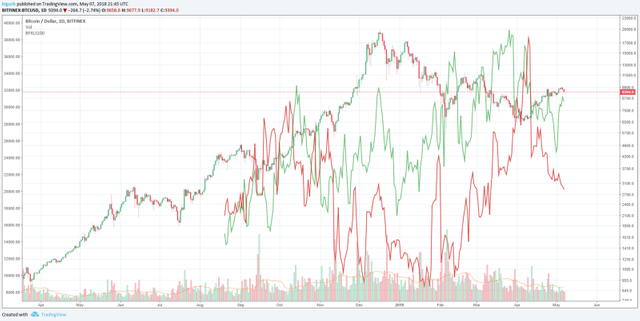
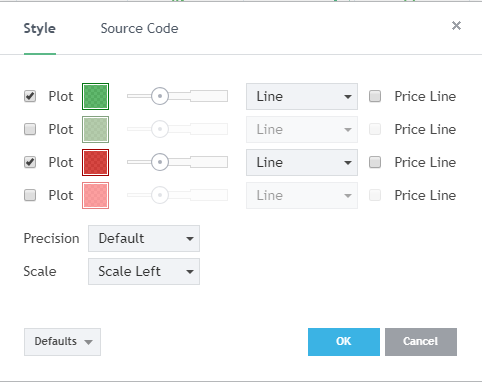
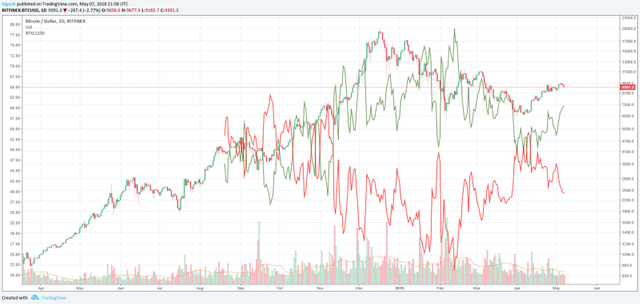
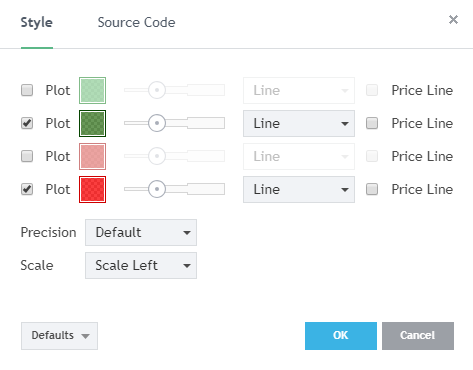
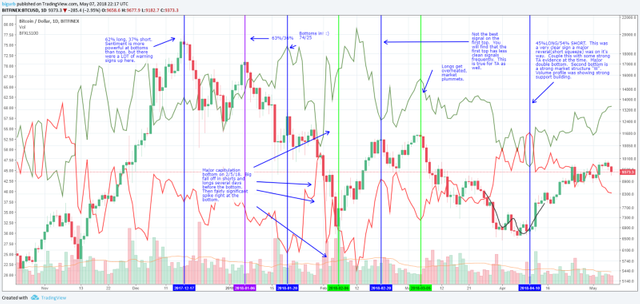
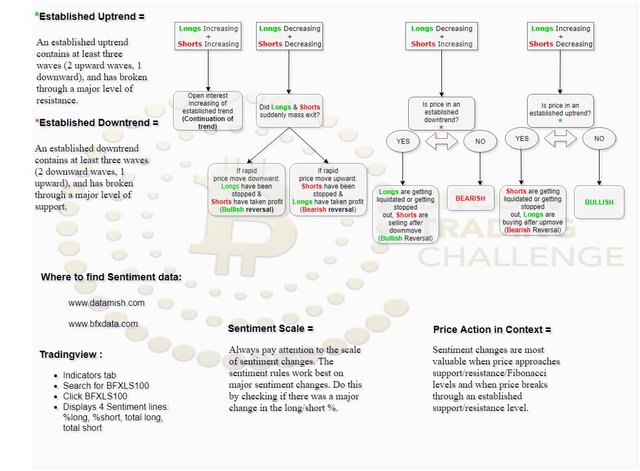
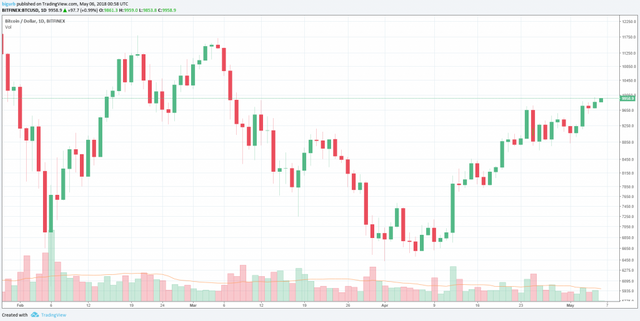
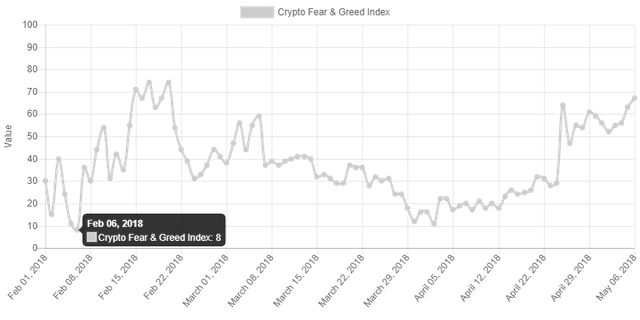




Congratulations @speculatefreedom! You have received a personal award!
Click on the badge to view your Board of Honor.
Do not miss the last post from @steemitboard!
Participate in the SteemitBoard World Cup Contest!
Collect World Cup badges and win free SBD
Support the Gold Sponsors of the contest: @good-karma and @lukestokes